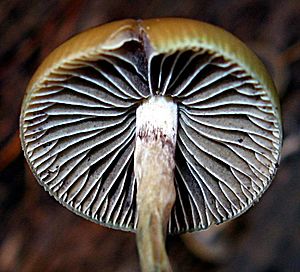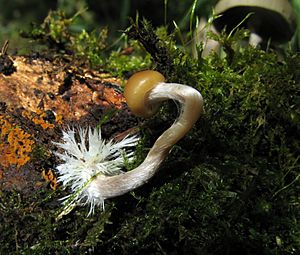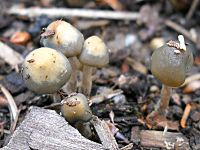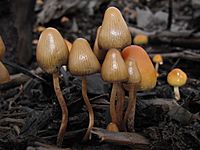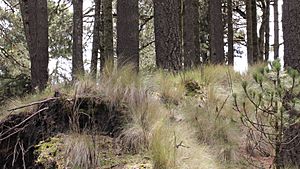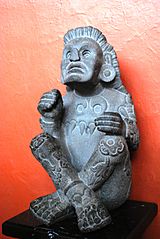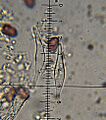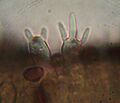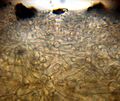Psilocybe aztecorum facts for kids
Quick facts for kids Psilocybe aztecorum |
|
|---|---|
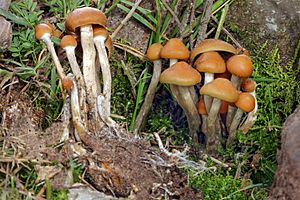 |
|
| In Nevado de Toluca, Mexico | |
| Scientific classification | |
| Genus: |
Psilocybe
|
| Species: |
aztecorum
|
| Synonyms | |
|
|
| Psilocybe aztecorum | |
|---|---|
| Mycological characteristics | |
| gills on hymenium | |
| cap is convex or campanulate | |
| hymenium is adnate or adnexed | |
| stipe is bare | |
| spore print is purple | |
| ecology is saprotrophic | |
| edibility: psychoactive | |
Psilocybe aztecorum is a type of psilocybin mushroom found in the Hymenogastraceae family. This fungus grows on rotting wood in high mountain areas, usually between 2,000 and 4,000 meters (about 6,500 to 13,000 feet) above sea level. You can find it in meadows or open forests with pine trees. It has been seen in places like Arizona, Colorado, central Mexico, India, and Costa Rica.
These mushrooms have caps that are 1.5 to 2 centimeters (about 0.6 to 0.8 inches) wide. Their caps can be rounded or bell-shaped. They sit on thin stems up to 7.5 centimeters (about 3 inches) long. The cap color changes depending on how much water it has. It can go from dark brown to straw yellow or even whitish when dry. A special feature of this mushroom is the thick white root-like structures called rhizomorphs at the base of its stem. This is not common for many Psilocybe mushrooms.
A French mushroom expert, Roger Heim, first mentioned this species in 1956. He first thought it was a type of Psilocybe mexicana. A year later, he gave it its current name, Psilocybe aztecorum. The name comes from the Nahua people, also known as the Aztecs. It is believed that P. aztecorum might have been one of the "sacred mushrooms" called teonanácatl by the Aztecs. This word means "sacred mushroom" or "flesh of the gods." These mushrooms were written about in old Aztec books by a Spanish writer named Bernardino de Sahagún in the 1500s.
Even today, some Nahua people in the Popocatépetl area still use these mushrooms in special spiritual ceremonies. However, this old tradition is slowly fading away. There is a type of P. aztecorum called P. aztecorum var. bonetii. It has smaller spores and grows at lower elevations, often near Montezuma pine and sacred fir trees. You can tell P. aztecorum apart from similar mushrooms like P. baeocystis and P. quebecensis by where they grow and by looking closely at their tiny parts under a microscope.
Contents
How Psilocybe aztecorum Got Its Name
The French mushroom expert Roger Heim first talked about this mushroom in 1956. He studied samples collected by R. Gordon Wasson from the Popocatépetl mountain in Mexico. Heim first thought it was a type of Psilocybe mexicana. He noticed its spores were longer and narrower than those of Psilocybe mexicana.
In 1957, Heim officially named the fungus Psilocybe aztecorum. He also described several other Mexican Psilocybe mushrooms. Later, in 1978, a Mexican mushroom expert named Gastón Guzmán added more details to the description of P. aztecorum. He included how the cap changes color when it dries and the root-like structures at the stem's base. Guzmán also described a new type, P. aztecorum var. bonetii, which has smaller spores.
The name aztecorum honors the Aztec people of central Mexico. They used this mushroom in their traditional ceremonies long before the Spanish arrived. The variety P. aztecorum var. bonetii is named after Dr. Federico Bonet, who helped Guzmán with his studies. People in Mexico sometimes call P. aztecorum niños or niñitos, which means "children" or "little children." In the Nahuatl language, it's called apipiltzin, meaning "children of the water," because it grows near ravines.
What Psilocybe aztecorum Looks Like
The cap of Psilocybe aztecorum starts out rounded or bell-shaped. As it gets older, it might flatten out or even form a dip in the middle. The cap can be 1.5 to 2 centimeters (about 0.6 to 0.8 inches) wide. When it's wet, the cap surface feels a bit slimy.
The cap changes color a lot depending on how much water it has. This is called being hygrophanous. It can be yellowish-brown when young, then turn brownish-gray as it ages. The edges might have greenish-gray tints. Later, it turns whitish from the center outwards. Dried mushrooms are straw-colored or pale brownish. Unlike most mushrooms in this group, the cap of P. aztecorum doesn't turn very blue when it's bruised, only the edges might get a slight blue-green stain.
The gills under the cap are attached to the stem. They are light violet-gray to dark violet-brown and might have whitish edges. The stem is hollow and measures 5.5 to 7.5 centimeters (about 2.2 to 3 inches) long and 3 to 4 millimeters (about 0.1 to 0.16 inches) thick. It can be straight or twisted. The stem surface is smooth and whitish to grayish. It stains blue-green if you touch it or as it gets older. The base of the stem has many white, root-like structures called rhizomorphs.
Young mushrooms have a thin, white, cobweb-like veil that covers the gills. This veil usually disappears quickly, but sometimes it leaves a small ring on the upper part of the stem. The inside of the mushroom is whitish to yellowish in the cap and reddish-brown in the stem. It doesn't turn very blue when injured. Fresh P. aztecorum smells and tastes a bit like fresh flour. Dried ones have a stronger smell. The spore print (the color of its spores) is blackish-violet.
Tiny Details of Psilocybe aztecorum
The spores of P. aztecorum are shaped like elongated ovals. They are about 12–14 by 6.6–7.7 by 6–7.5 micrometers in size. They have thick walls and a wide opening called a germ pore. The variety bonetii has smaller spores, measuring 10–13 by 6–7.5 by 6–7 micrometers.
The cells that produce spores are called basidia. They are usually attached to four spores. There are also special cells called cystidia on the edges of the gills. These are clear and shaped like a spindle or a bottle.
Similar Mushrooms
Psilocybe pseudoaztecorum, found in India, looks similar but has different shaped cystidia. The long, thin "neck" on the cystidia of P. aztecorum is missing in P. pseudoaztecorum.
Fresh P. aztecorum also looks like P. pelliculosa. However, P. pelliculosa only grows in the Pacific Northwest of the United States and Canada. The South African mushroom P. natalensis also turns almost white when it dries, just like P. aztecorum.
Another similar mushroom is P. baeocystis, found in northwest North America. It also turns white when dry. P. baeocystis has thinner cystidia than P. aztecorum. P. quebecensis, found only in Quebec, Canada, also has different sized cystidia.
Where Psilocybe aztecorum Grows
Psilocybe aztecorum is a type of mushroom that grows on dead wood. It helps break down dead wood, leaves, sticks, or other plant material. These mushrooms usually grow in groups of 5 to 20, and sometimes even in bigger clumps. They often grow on wood buried in the soil, small branches, very rotten logs, and sometimes even on pine cones.
You can find this mushroom in open forests with Hartweg's pine trees and certain grasses. It grows at high elevations, typically between 3,200 and 4,000 meters (about 10,500 to 13,000 feet). The first samples were found at 3,500 meters (about 11,500 feet) in a pine forest. P. aztecorum usually appears from August to October.
This mushroom is mainly found in the high mountains of central Mexico, like the Sierra Nevada and Nevado de Toluca. Experts believe it might also grow in other high mountain areas in Mexico with similar conditions. The variety bonetii grows on similar materials, mostly on humus (decaying plant matter). But it prefers forests with Montezuma pine and sacred fir trees, at lower elevations between 2,000 and 3,300 meters (about 6,500 to 10,800 feet). This variety also grows only in Mexico, usually from August to November. Because its natural home is shrinking, experts think P. aztecorum should be protected.
Traditional Use of Psilocybe aztecorum
Psilocybe aztecorum contains special natural compounds. In 1958, a chemist named Albert Hofmann found a small amount of one of these compounds in old samples. Experts like Paul Stamets describe P. aztecorum as having "moderate to high" effects.
The ancient Aztec "god of flowers," Xochipilli, has a 16th-century stone statue. This statue was found near the Popocatépetl volcano. The statue shows a figure sitting cross-legged, and its body is covered with carvings of sacred plants and organisms. Some round patterns on his knees, arm, and headdress are believed to be drawings of Psilocybe aztecorum mushrooms. Experts think these drawings show the mushroom caps just before they are fully grown.
P. aztecorum, along with P. caerulescens, is thought to be one of the mushrooms described by the 16th-century Spanish writer Bernardino de Sahagún. He called them teonanácatl, meaning "sacred or divine mushroom" or "flesh of the gods." The Aztecs considered these mushrooms holy. They used them in spiritual ceremonies to have special visions.
Today, Psilocybe aztecorum is still used in ceremonies by some indigenous people of Oaxaca and by Nahua people in the Popocatépetl region. However, this traditional use is slowly becoming less common. Traditional healers, called curanderos, still know about these mushrooms and other plants used in rituals. They sometimes use the mushrooms to help diagnose illnesses.
See also
 In Spanish: Psilocybe aztecorum para niños
In Spanish: Psilocybe aztecorum para niños
- Legal status of psilocybin mushrooms
- List of psilocybin mushrooms
Images for kids


